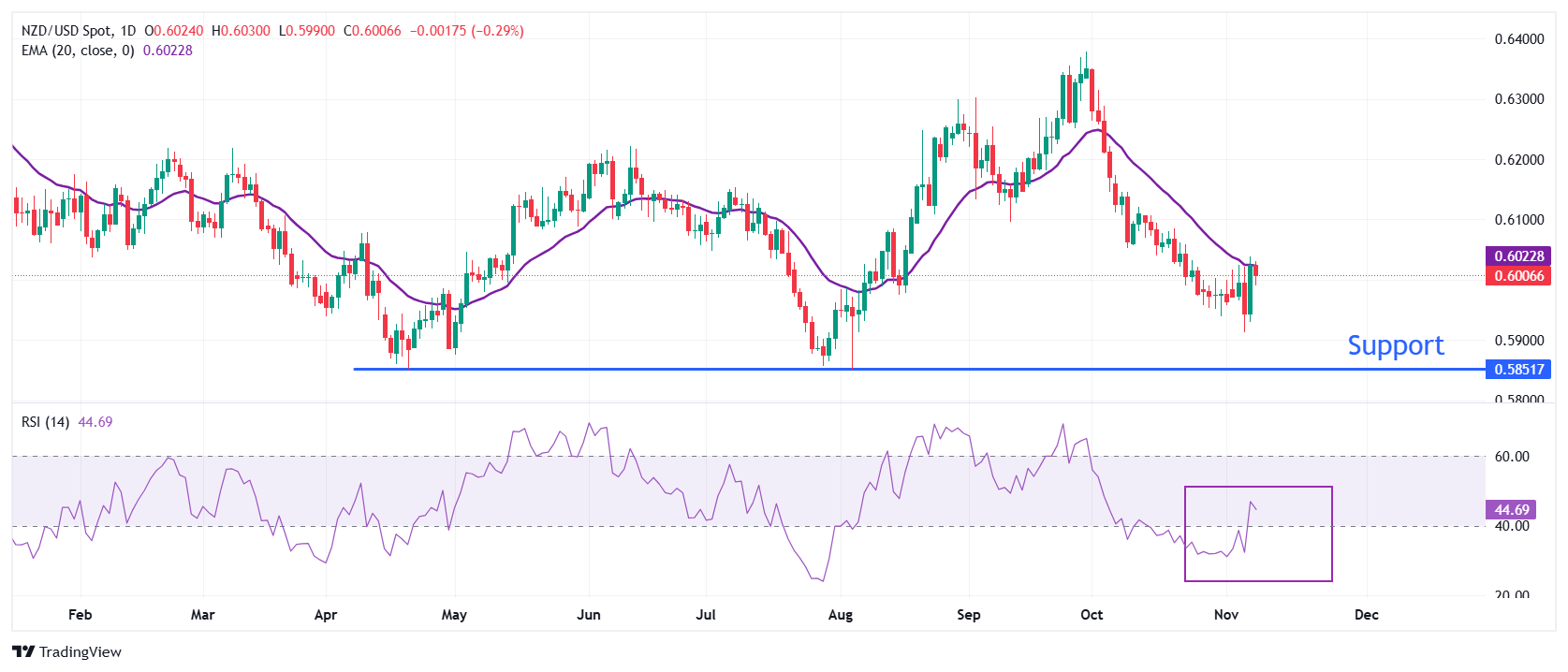- Analiza
- Novosti i instrumenti
- Vesti sa tržišta
- NZD/USD Price Forecast: Recovery stalls near 20-day EMA
NZD/USD Price Forecast: Recovery stalls near 20-day EMA
- NZD/USD corrects to near 0.6000 as the US Dollar bounces back.
- Trump’s protectionist policies would keep the US Dollar’s downside limited.
- The RBNZ is expected to cut interest rates again by 50 bps.
The NZD/USD pair struggles to extend Thursday’s recovery move above 0.6050 and corrects to near the psychological support of 0.6000 in Friday’s European session. The Kiwi pair faces slight pressure as the US Dollar (USD) rebounds after a sharp correction on Thursday. The US Dollar Index (DXY), which gauges Greenback’s value against six major currencies, bounces back from 104.20.
The USD gains as market participants expect that US Donald Trump’s tight external policies would improve the overall productivity, business investment, and spending for the longer term. Trump promised to raise import tariffs by 10% universally, except China, which is expected to face even higher duties.
Meanwhile, the outlook of the New Zealand Dollar (NZD) remains weak as poor labor demand has solidified speculation of another Reserve Bank of New Zealand (RBNZ) larger interest rate cut in its policy meeting on November 27.
New Zealand Q3 employment data showed that the laborforce reduced by 0.5%, faster than estimates of a 0.4% decline. The Unemployment Rate rose to 4.8%, slower than estimates of 5% but was higher than 4.6% in the second quarter of this year.
NZD/USD encounters offers after a mean-reversion move to near the 20-day Exponential Moving Average (EMA), which trades around 0.6023. The 14-day Relative Strength Index (RSI) returns above 40.00, suggesting that the bearish momentum has faded. However, the bearish bias remains intact.
More downside is highly likely towards the round-level support of 0.5900 and the April 19 low at 0.5850 if the pair breaks below the October 31 low of 0.5940.
On the flip side, a further recovery above the October 23 high of 0.6058 will drive the asset toward the round-level resistance of 0.6100 and the October 8 high of 0.6146.
NZD/USD daily chart
New Zealand Dollar FAQs
The New Zealand Dollar (NZD), also known as the Kiwi, is a well-known traded currency among investors. Its value is broadly determined by the health of the New Zealand economy and the country’s central bank policy. Still, there are some unique particularities that also can make NZD move. The performance of the Chinese economy tends to move the Kiwi because China is New Zealand’s biggest trading partner. Bad news for the Chinese economy likely means less New Zealand exports to the country, hitting the economy and thus its currency. Another factor moving NZD is dairy prices as the dairy industry is New Zealand’s main export. High dairy prices boost export income, contributing positively to the economy and thus to the NZD.
The Reserve Bank of New Zealand (RBNZ) aims to achieve and maintain an inflation rate between 1% and 3% over the medium term, with a focus to keep it near the 2% mid-point. To this end, the bank sets an appropriate level of interest rates. When inflation is too high, the RBNZ will increase interest rates to cool the economy, but the move will also make bond yields higher, increasing investors’ appeal to invest in the country and thus boosting NZD. On the contrary, lower interest rates tend to weaken NZD. The so-called rate differential, or how rates in New Zealand are or are expected to be compared to the ones set by the US Federal Reserve, can also play a key role in moving the NZD/USD pair.
Macroeconomic data releases in New Zealand are key to assess the state of the economy and can impact the New Zealand Dollar’s (NZD) valuation. A strong economy, based on high economic growth, low unemployment and high confidence is good for NZD. High economic growth attracts foreign investment and may encourage the Reserve Bank of New Zealand to increase interest rates, if this economic strength comes together with elevated inflation. Conversely, if economic data is weak, NZD is likely to depreciate.
The New Zealand Dollar (NZD) tends to strengthen during risk-on periods, or when investors perceive that broader market risks are low and are optimistic about growth. This tends to lead to a more favorable outlook for commodities and so-called ‘commodity currencies’ such as the Kiwi. Conversely, NZD tends to weaken at times of market turbulence or economic uncertainty as investors tend to sell higher-risk assets and flee to the more-stable safe havens.
© 2000-2024. Sva prava zaštićena.
Sajt je vlasništvo kompanije Teletrade D.J. LLC 2351 LLC 2022 (Euro House, Richmond Hill Road, Kingstown, VC0100, St. Vincent and the Grenadines).
Svi podaci koji se nalaze na sajtu ne predstavljaju osnovu za donošenje investicionih odluka, već su informativnog karaktera.
The company does not serve or provide services to customers who are residents of the US, Canada, Iran, The Democratic People's Republic of Korea, Yemen and FATF blacklisted countries.
Izvršenje trgovinskih operacija sa finansijskim instrumentima upotrebom marginalne trgovine pruža velike mogućnosti i omogućava investitorima ostvarivanje visokih prihoda. Međutim, takav vid trgovine povezan je sa potencijalno visokim nivoom rizika od gubitka sredstava. Проведение торговых операций на финанcовых рынках c маржинальными финанcовыми инcтрументами открывает широкие возможноcти, и позволяет инвеcторам, готовым пойти на риcк, получать выcокую прибыль, но при этом неcет в cебе потенциально выcокий уровень риcка получения убытков. Iz tog razloga je pre započinjanja trgovine potrebno odlučiti o izboru odgovarajuće investicione strategije, uzimajući u obzir raspoložive resurse.
Upotreba informacija: U slučaju potpunog ili delimičnog preuzimanja i daljeg korišćenja materijala koji se nalazi na sajtu, potrebno je navesti link odgovarajuće stranice na sajtu kompanije TeleTrade-a kao izvora informacija. Upotreba materijala na internetu mora biti praćena hiper linkom do web stranice teletrade.org. Automatski uvoz materijala i informacija sa stranice je zabranjen.
Ako imate bilo kakvih pitanja, obratite nam se pr@teletrade.global.
















